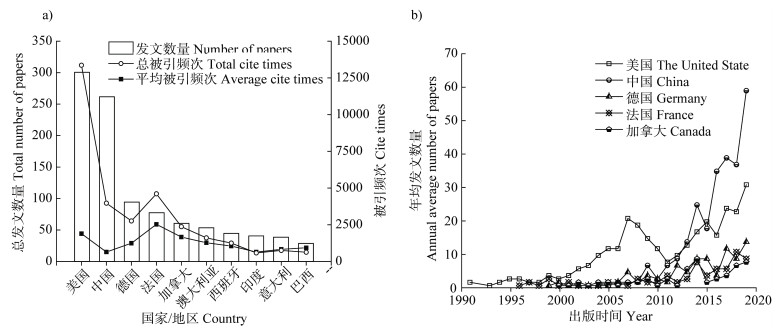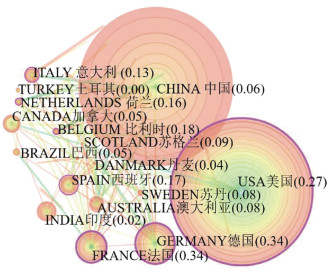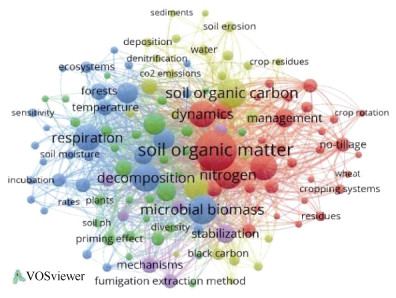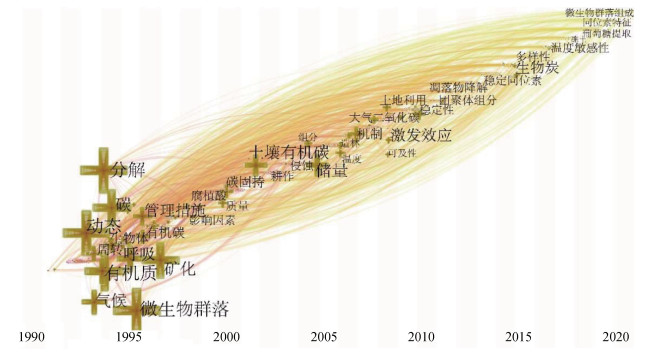2. 西北农林科技大学水土保持研究所, 陕西杨凌, 712100;
3. 中国科学院大学, 北京, 100049
2. Institute of Soil and Water Conservation, Northwest A & F University, Yangling, Shaanxi 712100, China;
3. University of Chinese Academy of Sciences, Beijing 100049, China
土壤是地球系统大气圈、水圈、岩石圈及生物圈相互作用最复杂、最活跃的交界面[1],同时也是陆地生态系统中重要的碳库,其有机碳储量为1 576 Pg,超过大气和植被有机碳储量的总和[2]。想要重新进入土壤生物地球化学循环的各种土壤有机质,必须经过分解和矿化过程。土壤有机碳矿化是土壤碳库向大气中释放CO2的最大净输出途径,其0.1%的变化将导致大气圈CO2浓度1 mg·L–1的变化,并可通过与植被的净初级生产力的差值判断是碳源还是碳汇[3],所以土壤有机碳矿化在全球碳循环中发挥着重要作用。当前影响土壤碳矿化的因素主要包括土壤温湿度[4-5]、耕作管理措施[6-9]、氧的有效性[2]、CO2的浓度[10]、添加外源碳氮磷[11-12]和土壤理化性质[13-14]等。有研究表明,当温度升高时,由于土壤酶失活使得土壤有机碳矿化速率下降[15]。当温度恒定时,主导有机碳矿化速率的因素就变为了其他环境因素,比如湿度、培养时间、外源碳氮磷的添加等。大量研究证明,随着土壤湿度的增加,土壤有机碳矿化速率增加,其主要内在原因可能是由于湿度的增加显著增加了微生物的活性,进而促进有机质分解和矿化。而土壤有机碳矿化对于培养时间的响应是复杂的:在培养早期,温度对土壤有机碳矿化是产生正向的促进作用,所有土壤中可利用的碳都为微生物提供了充足的食物;在培养后期时,可利用的碳被消耗完以后就剩下难分解的、稳定的碳,导致微生物的分解速率下降,进而影响矿化速率[16-18]。外源碳氮磷的添加主要是为土壤微生物提供营养,使其活性增加,从而加快土壤有机碳矿化速率。此外,有机碳矿化是个复杂的过程,有研究通过核磁共振和热分析技术探究长期土壤有机碳矿化、微生物活性及激发效应对有机碳矿化的动力学机制[19-21]。
当前关于有机碳矿化的研究十分广泛并且种类繁多,而文献计量法可有效总结研究成果并揭示其未来的发展方向。因此,本文引入文献计量学的方法探究土壤有机碳矿化已有文献的内在关联和潜在热点,利用统计学和数学的方法,量化各种评价指标,描述土壤有机碳矿化研究的性质和方向。通过对检索文献的聚类、分析和可视化,显示土壤有机碳矿化在1982—2020年开展的科学研究的发展历程和结构关系,并对此进行描述。
1 数据与方法 1.1 数据收集Web of Science是一个综合多学科核心期刊的数据库。本文选用Web of Science核心合集(Science Citation Index Expanded,SCIE)数据库作为数据源,检索式为:(TI =((mineralizat*)and("soil carbon" or "soil organic carbon" or "SOC")))OR(AB =((mineralizat*)and("soil carbon" or "soil organic carbon" or "SOC")))。检索时间为2020年7月7日。使用该检索式共检索到文献1 435篇,检索到的文献类型包括论文、会议记录、会议摘要和综述。为减小误差、提高精度,将文献导入到Endnote中逐条整理挑选,删除重复文献、会议论文,以及与研究主题和检索式不符合的文献。经筛选后共获取文献1 045篇,将选取的文献通过馆藏号重新检索和选取并以.txt格式导出。
1.2 数据分析利用Web of Science的分析检索结果功能,对检索到的文献进行分类存储,运用Excel对年发文量、发文国家、发文机构、发文作者等进行统计,同时使用了CiteSpace和VOS viewer对文献的标题、摘要、关键词中提取重要的名词短语进行文献共词、共现和突现词分析,并使用以上两个软件和GIS进行绘图以获得有机碳矿化的发展历程和研究热点图。在CiteSpace(5.6.R3)中选择时间跨度为1982—2020年,时间节点设置为1年,节点类型选择Country(国家)、Keyword(关键词),节点强度默认Cosine(余弦函数),阈值选择TOP 50,网络裁剪功能区选择Minimum Spanning Tree(最小生成树)进行图谱分析,在分析关键词随时间变化时,选择time-zone。使用VOS viewer对关键词、作者进行分析,选择数据类型来源于WOS,计数方法设置为Full counting(全计数)并添加词表用以清洗数据,而后设置词条最小出现频次,最终形成图谱。
2 结果与讨论 2.1 时间发展脉络学术领域每年的发文数量能在一定程度上代表该领域在近年来被关注的趋势[22]。有机碳矿化的论文数量总体呈现出上升趋势,并大致分为两个阶段:第一阶段为1982—1993年,发文量较少,研究处于萌芽期。1982年发表了第一篇与关于有机碳矿化的论文,10年内仅有7篇有机碳矿化的论文。第二阶段为1993—2019年,是研究的高速发展期(图 1)。从1993年开始,有机碳矿化的论文数量稳步增长,其主要原因可能是由于1992年通过了《联合国气候变化框架公约》,该条约第二条明确规定的最终目标为:“减少温室气体(CO2、CH4、N2O等)排放,减少人为活动对气候系统的危害,减缓气候变化,增强生态系统对气候变化的适应性,确保粮食生产和经济可持续发展。”由于土壤碳库巨大的碳储量,就成为了极度需要保护的碳源和碳汇地。在2013年时,全球大气CO2浓度首次超过了400 mg·L–1 [23],之后发文数量呈指数型增长。发文数量在2019年达到121篇,被引频次高达4400多次,且有持续增长的趋势。这些政策和学术成果有效推动了科研人员对有机碳矿化的研究工作,说明在学术成果日益增多的同时,科研人员对于有机碳矿化的认知也越来越深入。

|
图 1 有机碳矿化的年度发文数量及被引频次 Fig. 1 Annual number of papers and cited times on organic carbon mineralization |
美国是总发文数量第一的国家,发文量为302篇,总被引频次高达13 360次,说明研究受到领域内学者们的认可(图 2a)。中国的总发文数量排名第二,总被引频次逐年上升但平均被引频次较低,说明论文的创新性和影响力有待提高(图 2a,图 3)。美国年均发文量呈现出平稳增长状态;中国的有机碳矿化研究虽起步较晚,但自2010年起论文数量大幅增长,并从2016年起年均发文数量超过美国,成为年均发文数量第一的国家(图 2b)。

|
图 2 排名前10的国家的发文数量与被引频次(a)及排名前5的国家1990—2020年的年发文量(b) Fig. 2 The number of papers and citations of the top 10 countries(a) and the annual number of papers published by the top 5 countries(b) |

|
图 3 有机碳矿化的国家合作图 Fig. 3 Cooperation between major countries in the field of organic carbon mineralization |
图 3显示了各个国家之间的发文数量、合作关系及其文章影响力,节点大小代表文章数量,连线代表合作关系,括号内数字代表中介中心性,具有粉紫色外圈代表中介中心性大于0.1。由于中介中心性是用来测试节点在网络中重要性的指标,并以此来发现和衡量文献的重要程度[24],所以国家中介中心性用来代表该国家在某研究领域的国际影响力[25]。美、中、德、法之间合作强度高且与其他国家的合作较为紧密(图 3)。对国家的中介中心性进行排名,法国和德国的中介中心性最高为0.34,中国虽年均发文数量已经成为第一,但中介中心性(0.06)仅为德法两个国的17.6%。表明近年来中国虽在该研究领域较为活跃,但研究成果的国际影响力并不高,应加强在该领域的科研创新性。
2.3 发文机构中国科学院是发文数量和合著发表文章数量第一的机构,其次分别是美国农业部和法国农业研究院(表 1)。经VOS viewer统计,共出现了1 153个研究机构,合著发表了2篇(≥2)文章的机构共有369个(数据未显示),占合作机构总数的32%。说明机构之间的合作较为紧密,学术交流与合作较为频繁。对中国科学院从属机构展开后发现沈阳应用生态研究所(27篇)、水土保持研究所(26篇)、东北地理与农业生态研究所(25篇)和南京土壤研究所(19篇)等科研院所做出了杰出贡献。沈阳应用生态研究所的研究地区主要集中在亚热带、温带地区的森林和高山高寒草地上,研究内容为通过输入外源碳氮、改变立地条件等探究碳氮动态变化、微生物生物量和群落结构、酶活性以及(根际)激发效应对土壤碳矿化产生的影响;水土保持研究所的研究地区集中在黄土高原和青藏高原的退化土壤、高山草甸土壤上,研究内容为碳氮的分布与碳矿化的稳定性、温度敏感性和温室气体的排放在不同土地利用方式和土壤管理制度、生物炭和氮的添加以及土壤侵蚀沉积与植被恢复下的响应机制;东北地理农业生态研究所的研究地区主要集中在东北的黑土地区、淡水湿地和淡水沼泽上,研究内容为不同土地利用和耕作管理方式、氮和凋落物的输入以及温湿度对土壤有机碳矿化和碳氮氧化物的温度敏感性的影响;南京土壤所的研究地区较为广泛,研究内容主要为不同土地利用方式下,长期或短期添加外源物质产生的有机碳矿化的差异以及碳动态变化。
|
|
表 1 发文数量在前5的机构及其他信息 Table 1 Top 5 most published institutions on organic carbon mineralization |
排在第二的是美国农业部,总被引频次为1 777次,平均被引频次为46.76。其研究区域主要集中在旱地和半干旱地区,研究内容为耕作制度、温湿度或干湿交替等对土壤碳氮组分、矿化能力和土壤碳库的影响。排名前5的研究机构中,美国的研究机构占比为40%,其文章的平均被引频次较高,可能由于研究内容多为大空间尺度下的碳动态(如碳组分变化、碳收支平衡等),被大量研究学者引用。
2.4 作者与合作经VOS viewer统计显示共有4 290名作者进行了土壤有机碳矿化的研究,经过数据清洗后,整理出发文数量在前5的作者。表 2表明,俄亥俄州立大学的Lal R是发文数量最多的作者(26篇),总被引频次也最高,在此数据集为1 572次。
|
|
表 2 发文数量在前5的作者及其他信息 Table 2 Top 5 most published researchers on organic carbon mineralization |
在VOS viewer中检测到的核心作者共有211位,核心作者是推动学术创新和发展力量的主要人员,通过对其发文量的分析,可以有效识别研究领域的发展脉络。根据普莱斯理论[26]:

|
图 4 基于VOS viewer分析有机碳矿化论文的作者合作图 Fig. 4 Network visualization of authors cooperation based on VOS viewer |
在GIS软件中使用Kriging插值法绘出研究领域的发文数量图,每个等高线之间有66篇文章。图 5中红色部分代表发文量密集,蓝色部分代表发文量稀疏。发文数量最多的4个研究领域为农业、生态环境科学、地理学和植物科学领域,其中农业领域占所有研究领域中的43.44%。发文数量第二的是生态环境科学,占比为28.25%,这两个研究领域更受研究人员的重视,其研究成果可用于生产实践与环境保护,因此其发表的文章数量占论文总数的70%以上。

|
图 5 有机碳矿化研究领域与发文数量分布图 Fig. 5 Distribution map of research field and numbers on organic carbon mineralization |
关键词是文献研究主题高度概括,可以将论文准确、精炼的表达出来。通过分析关键词,有助于研究者了解该领域的热点和发展趋势[40]。关键词中出现频次最高的为soil organic matter(465次)。根据计算,核心词汇出现的频次应大于等于16(N=16.13),共有124个核心词汇。关键词的共现和聚类情况如图 6所示。

|
图 6 有机碳矿化的关键词网络图 Fig. 6 Network visualization of keyword on organic carbon mineralization |
红色聚类组内的核心词汇为土壤有机质、碳氮动态、土地利用变化等。该聚类组的研究内容主要是土地利用变化造成土壤有机质的改变和矿化,从而影响碳固持和周转。研究表明有机质的添加会显著增加土壤有机碳矿化,其次,有机质在不同土地利用方式下,其输入和输出会使得土壤性质发生改变,从而导致土壤碳矿化释放的二氧化碳含量具有较大差异,进而影响土壤有机碳的组成和矿化过程[41-42]。需进一步加强的研究为:不同来源和不同土地利用条件下的有机质添加后对土壤有机碳矿化的影响机制[43]。
绿色聚类组内的核心词汇为激发效应和生物炭。该聚类组的研究内容主要是外源物质在土壤有机碳发生矿化时产生的正负激发效应。激发效应是指外源物质进入土壤使得土壤原有的有机碳C或N矿化速率发生改变的现象[44]。这一现象是外源物质与土壤元素交互作用的结果。由于外源物质输入而导致分解速率加快被定义为正激发效应;对分解速率产生抑制作用则定义为负激发效应[45]。影响激发效应的因素有很多,如外源物质的性质和数量、土壤性质、氮肥的施用、土壤中的微生物等[46]。目前实验中添加的主要外源物质是生物炭,有研究表明添加外源生物炭对土壤有机碳矿化产生明显作用[47],但由于试验条件的不同导致了不同的结果,所以研究者们开始探究生物炭对土壤有机碳矿化的内在作用机制。现有的内在作用机制主要有两种:一种是生物炭进入土壤环境后由于其内部孔隙结构和外表面对土壤有机质的吸附保护可以发挥固碳作用,促进土壤无机—有机复合体稳定,对土壤中微生物和酶存在抑制作用,增加碳的储存;另一种是生物炭进入土壤后为微生物提供碳源,促进微生物的活动,土壤和生物炭中易分解的组分被矿化,最终促进了土壤碳的排放[48]。关于生物炭对土壤有机碳矿化产生影响的机理需进一步深入。
蓝色聚类组内的核心词汇有微生物生物量(碳)、土壤呼吸、气候变化和碳矿化。此聚类组集合了微生物在有机碳矿化的研究,包括了微生物的类型和群落结构以及微生物在矿化过程中进行的r/K选择策略等[49-50]。微生物生物量碳是土壤有机质里最易发生变化和性质最活跃的组分[51],虽然在土壤碳库里的比例较小,但却是土壤有效碳的供应源[52]。许多研究表明,微生物生物量碳含量与土壤有机碳矿化速率存在极显著的相关性,甚至可与激发效应相链接[53-55];微生物对有机碳储量也具有重要影响,其通过与有机矿物的相互作用来影响碳储量,因此了解微生物作用机制及其相互依赖性十分重要[56]。土壤有机碳矿化时土壤会发生呼吸作用,微生物会分解有机质中的碳,在有氧呼吸时释放CO2,无氧呼吸时释放CH4等温室气体,从而进行碳降解功能。所以矿化作用离不开微生物,也离不开呼吸作用。微生物体中碳的转化过程有两种:一种是在微生物的作用下矿化和释放温室气体到大气中去;或经过微生物的利用,变成微生物生物量碳和微生物残留物,然后经过长期的累积形成稳定碳库。气候变化同样对土壤碳库的周转过程造成巨大的影响[57]。
黄色聚类组内的突出词汇为土壤有机碳、侵蚀与沉积等。中国是全球水土流失最严重的国家,水土流失占国土面积的51.1%[58]。有侵蚀就有沉积,侵蚀和沉积会造成土壤理化性质改变,导致不同土层或不同位置的环境要素如温度、湿度等产生异质性。之后经过侵蚀的分选,土壤团聚体在不同位置分散或聚集,导致有机碳水平差异大,微生物生物量碳等含量差异也增大,空间分异加剧且存在季节性和年际之间的差异[59]。目前由侵蚀引起的土壤碳矿化的含量和机制尚不明确,因侵蚀而流失的碳和留在原位的碳的动态仍缺少明确的理论解释,无法估算有机碳库因侵蚀而发生的矿化流失[60-61]。
紫色聚类组内的核心词汇为稳定性机制、碳储量与碳周转。研究中涉及的稳定机制有化学、物理和生物稳定机制。对土壤有机碳稳定性影响较大的为生物稳定性,包括植物自身稳定性和土壤生物稳定性。如土壤生物在分解植物时,由于植物自身稳定性(大分子或芳香环结构)导致植物很难被降解,就会产生残留物和土壤生物自身代谢的分泌物,从而在土壤中形成稳定有机碳库[62]。碳的稳定性越高,碳矿化的速度越慢,说明碳周转越慢。而土壤中的有机碳进行分解、转化和输出是土壤碳周转的生态过程。气候因素、土壤理化性质、植被类型和状况、土地利用方式的影响、微生物群落结构、相关酶的活性以及接触程度等均会影响碳周转的过程[63-67]。需加深这些影响因素对碳周转和建模的作用,同时确定非线性土壤C动力学过程(如激发效应)对碳循环的贡献[56]。
将综上所述的研究热点进行深入挖掘,可以看出,当前学者们对土壤有机碳矿化的影响因素以及外源物质添加后有机碳矿化的变化趋势进行了着重研究,但微生物与激发效应在土壤有机碳矿化中扮演的角色尚不明确。此外,温度敏感性和土壤有机碳矿化对土壤碳排放与固持的解释程度及其内在机理的研究力量尚显薄弱。未来有机碳矿化研究应加强对矿化机理的了解,从多个学科、多个尺度、多个领域对其进行解释。
2.7 研究热点的演变图 7是对文章中的科学名词进行提取后,根据其首次出现的时间及其出现频次绘制的时间区划图(time-zone),可体现研究的发展进程。图中具有十字标记代表在该年份出现频次激增的关键词,说明此关键词是该年份新出现的研究前沿和热点;图中的关键词具有不同的字号,关键词字号越大说明出现的频次越高,受到的关注也越多。由图 7可知早期对土壤有机碳矿化的研究集中在微生物群落,管理措施,碳动态等方面上,近年来研究逐渐偏向激发效应、生物炭和土壤侵蚀等研究方向,并涉及到土壤、微生物、植被、大气等诸多研究对象。近10年来的研究前沿为温度敏感性、激发效应、微生物群落结构、模型等,与关键词的热点和前沿具有一致性。

|
图 7 研究热点在1990—2020年间的变化图 Fig. 7 The chart shows the change in hotspots of research from 1990 to 2020 |
土壤有机碳矿化研究自1982年起,经历了研究萌芽期(1982—1993)和高速发展期(1993—2019)。近30年来有关土壤有机碳矿化研究的文献数量快速增加并具有持续增长的潜力。通过文献计量法对土壤有机碳矿化的研究进行分析,结果表明美国总发文量最大且与其他国家合作密切,同时具有较高的中介中心性,说明其科研能力和国际影响力受到领域内学者们的认可。与国外同类研究相比,中国在土壤有机碳矿化领域的研究起步较晚,但近20年来发展迅速,甚至在2016年时年均发文量超过美国,而后保持年均发文量第一,但由于研究的滞后性使得文献的平均被引频次不高,需加强本研究领域的科研创新性和国际影响力。对研究机构进行统计分析,中国科学院是发文数量第一的研究机构,远超美国农业部,但存在平均被引频次较低的情况。对研究领域进行分析发现土壤有机碳矿化受到多学科、多领域的广泛关注,因此带来学科之间知识的交叉融合,从而使得新兴研究领域和主题不断涌现。今后应更加注重学科与领域之间的融会贯通,为土壤有机碳矿化研究提供新思路。
当前土壤有机碳矿化的研究方向不断转化,研究内容的广度和深度不断得到拓展,研究对象呈现出多样性,如植被、微生物、土壤、大气等。总体而言,土壤有机碳矿化的研究尺度涉及到群落、生态系统、景观、区域和全球等,呈现出两极分化性,如土壤有机碳矿化的模型与机制的研究由中小尺度转向大尺度研究,而研究土壤有机碳矿化的影响因素等则由宏观的变化趋势转向由微观的生物动态和化学键能加以阐释。由于影响土壤有机碳矿化的影响因子较多,如土壤类型、土地利用变化、气候变化等,因此,外部环境条件对土壤有机碳矿化量,周转量及其时空分布状况具有重要影响。尽管当前土壤有机碳矿化的文章已有很多,但还有很多方面不够成熟,有关土壤有机碳矿化的机理需进一步深化,模型体系相对较少。综上所述,不同条件下的土壤有机碳矿化的研究需更有针对性和综合性:今后应更加注重土壤有机碳矿化在不同环境因素、不同土地利用条件下的内在机制研究,为全球碳储量、碳周转与循环模型提供准确的参数与路径,对缓解温室效应和提高碳储量提供理论依据;应深化外源碳氮添加产生的激发效应对土壤有机碳矿化的影响机理研究,明确发生变化的关键因子及其内在机制;应弄清不同稳定性的碳与侵蚀—沉积碳在土壤有机碳矿化时所起作用及其变化规律,为土壤碳稳定性机制提供研究思路和理论依据。
致谢 感谢中国科学院文献情报中心宋秀芳老师对检索式的修订以及提供本文所使用到的文献计量分析方法;感谢中国科学院东北地理与农业生态研究所李禄军老师对本文关于土壤有机碳矿化的内容进行专业上的指导和帮助。
| [1] |
Li T, Ma X T, Li C J, et al. Analysis on the international development trend of soil microbial research literature based on web of science (In Chinese)[J]. Northern Horticulture, 2017(10): 198-207. [李通, 马雪婷, 李春杰, 等. 基于Web of Science的土壤微生物研究文献国际发展态势分析[J]. 北方园艺, 2017(10): 198-207.]
(  0) 0) |
| [2] |
Yuan Z, Zhou Z Y, Zhao H T, et al. Variability in soil organic carbon mineralization due to different temperatures, moisture contents, and incubation periods in three Taiyue Mountain forest ecosystems (In Chinese)[J]. Chinese Journal of Applied and Environmental Biology, 2019, 25(5): 1021-1029. [袁瑱, 周志勇, 赵洪涛, 等. 太岳山森林土壤有机碳矿化随温度、湿度和培养时间的变化特征[J]. 应用与环境生物学报, 2019, 25(5): 1021-1029.]
(  0) 0) |
| [3] |
Wang H, Fan Z P, Deng D Z, et al. Effects of environmental factors on soil organic carbon mineralization in a Pinus sylvestris var.mongolica plantation (In Chinese)[J]. Chinese Journal of Ecology, 2008, 27(9): 1469-1475. [王红, 范志平, 邓东周, 等. 不同环境因子对樟子松人工林土壤有机碳矿化的影响[J]. 生态学杂志, 2008, 27(9): 1469-1475.]
(  0) 0) |
| [4] |
Wang X W, Li X Z, Hu Y M, et al. Effect of temperature and moisture on soil organic carbon mineralization of predominantly permafrost peatland in the Great Hing'an Mountains, Northeastern China[J]. Journal of Environmental Sciences, 2010, 22(7): 1057-1066. DOI:10.1016/S1001-0742(09)60217-5
(  0) 0) |
| [5] |
Norton U, Saetre P, Hooker T D, et al. Vegetation and moisture controls on soil carbon mineralization in semiarid environments[J]. Soil Science Society of America Journal, 2012, 76(3): 1038-1047. DOI:10.2136/sssaj2011.0270
(  0) 0) |
| [6] |
Yang X M, Drury C F, Wander M M. A wide view of no-tillage practices and soil organic carbon sequestration[J]. Acta Agriculturae Scandinavica, Section B-Soil & Plant Science, 2013, 63(6): 523-530.
(  0) 0) |
| [7] |
Zhang P, Li H, Jia Z K, et al. Effects of straw returning on soil organic carbon and carbon mineralization in semi-arid areas of southern ningxia, China (In Chinese)[J]. Journal of Agro-Environment Science, 2011, 30(12): 2518-2525. [张鹏, 李涵, 贾志宽, 等. 秸秆还田对宁南旱区土壤有机碳含量及土壤碳矿化的影响[J]. 农业环境科学学报, 2011, 30(12): 2518-2525.]
(  0) 0) |
| [8] |
Chen S L, Hu J M, Huang Z H, et al. Effects of smash ridging on soil organic carbon mineralization and structure of sugarcane field in flat and slope farmland (In Chinese)[J]. Chinese Journal of Agrometeorology, 2020, 41(5): 299-307. DOI:10.3969/j.issn.1000-6362.2020.05.004 [陈仕林, 胡钧铭, 黄忠华, 等. 粉垄耕作对平地和坡耕地蔗田土壤有机碳矿化和结构的影响[J]. 中国农业气象, 2020, 41(5): 299-307.]
(  0) 0) |
| [9] |
Luo Y J, Zhao G, Gao M, et al. Organic carbon distribution in aggregates and soil organic carbon mineralization in different vegetation covering (In Chinese)[J]. Journal of Soil and Water Conservation, 2010, 24(6): 117-122. [罗友进, 赵光, 高明, 等. 不同植被覆盖对土壤有机碳矿化及团聚体碳分布的影响[J]. 水土保持学报, 2010, 24(6): 117-122.]
(  0) 0) |
| [10] |
Wang H, Yang B S, Dai S H. Accumulation and distribution of soil organic carbon in Phragmites communis wetlands restored with ecological engineering[J]. Advanced Materials Research, 2013, 684: 203-206. DOI:10.4028/www.scientific.net/AMR.684.203
(  0) 0) |
| [11] |
Wei Y Y, Cui L J, Zhang M Y, et al. Effects of exogenous carbon input on soil organic carbon mineralization and temperature sensitivity of cropland and wetland in the North China Plain (In Chinese)[J]. Chinese Journal of Eco-Agriculture, 2019, 27(10): 1463-1471. [魏圆云, 崔丽娟, 张曼胤, 等. 外源碳输入对华北平原农田和湿地土壤有机碳矿化及其温度敏感性的影响[J]. 中国生态农业学报, 2019, 27(10): 1463-1471.]
(  0) 0) |
| [12] |
Lin Q M, Liao C L, Xie L H, et al. Effects of groundwater tables and long-term fertilization on mineralization of organic carbon in red paddy soil (In Chinese)[J]. Acta Pedologica Sinica, 2019, 56(6): 1414-1424. [林清美, 廖超林, 谢丽华, 等. 地下水位和长期施肥对红壤性水稻土有机碳矿化特征的影响[J]. 土壤学报, 2019, 56(6): 1414-1424.]
(  0) 0) |
| [13] |
Li S J, Qiu L P, Zhang X C. Mineralization of soil organic carbon and its relations with soil physical and chemical properties on the Loess Plateau (In Chinese)[J]. Acta Ecologica Sinica, 2010, 30(5): 1217-1226. [李顺姬, 邱莉萍, 张兴昌. 黄土高原土壤有机碳矿化及其与土壤理化性质的关系[J]. 生态学报, 2010, 30(5): 1217-1226.]
(  0) 0) |
| [14] |
Ren X E, Tong C L, Sun Z L, et al. Effects of temperature on organic carbon mineralization in paddy soils with different clay content (In Chinese)[J]. Chinese Journal of Applied Ecology, 2007, 18(10): 2245-2250. [任秀娥, 童成立, 孙中林, 等. 温度对不同粘粒含量稻田土壤有机碳矿化的影响[J]. 应用生态学报, 2007, 18(10): 2245-2250.]
(  0) 0) |
| [15] |
Alvarez G, Shahzad T, Andanson L, et al. Catalytic power of enzymes decreases with temperature: New insights for understanding soil C cycling and microbial ecology under warming[J]. Global Change Biology, 2018, 24(9): 4238-4250. DOI:10.1111/gcb.14281
(  0) 0) |
| [16] |
Conant R T, Drijber R A, Haddix M L, et al. Sensitivity of organic matter decomposition to warming varies with its quality[J]. Global Change Biology, 2008, 14(4): 868-877. DOI:10.1111/j.1365-2486.2008.01541.x
(  0) 0) |
| [17] |
Fissore C, Giardina C P, Kolka R K. Reduced substrate supply limits the temperature response of soil organic carbon decomposition[J]. Soil Biology & Biochemistry, 2013, 67: 306-311.
(  0) 0) |
| [18] |
Hamdi S, Moyano F, Sall S, et al. Synthesis analysis of the temperature sensitivity of soil respiration from laboratory studies in relation to incubation methods and soil conditions[J]. Soil Biology & Biochemistry, 2013, 58: 115-126.
(  0) 0) |
| [19] |
Kurganova I, Merino A, Lopes de Gerenyu V, et al. Mechanisms of carbon sequestration and stabilization by restoration of arable soils after abandonment: A chronosequence study on Phaeozems and Chernozems[J]. Geoderma, 2019, 354: 113882. DOI:10.1016/j.geoderma.2019.113882
(  0) 0) |
| [20] |
Futter M N, Butterfield D, Cosby B J, et al. Modeling the mechanisms that control in-stream dissolved organic carbon dynamics in upland and forested catchments[J]. Water Resources Research, 2007, 43(2): W02424.
(  0) 0) |
| [21] |
Fang Y Y, Nazaries L, Singh B K, et al. Microbial mechanisms of carbon priming effects revealed during the interaction of crop residue and nutrient inputs in contrasting soils[J]. Global Change Biology, 2018, 24(7): 2775-2790. DOI:10.1111/gcb.14154
(  0) 0) |
| [22] |
Zheng M Y, Lin W, Xu Q, et al. Bibliometric analysis of soil acidification research based on CNKI database (In Chinese)[J]. Soils, 2020, 52(4): 811-818. [郑梅迎, 林伟, 徐茜, 等. 基于CNKI数据库的土壤酸化文献计量分析[J]. 土壤, 2020, 52(4): 811-818.]
(  0) 0) |
| [23] |
Kodaira H. Responding to climate change and expectations for research[J]. Paddy and Water Environment, 2014, 12(2): 211-212.
(  0) 0) |
| [24] |
Du H, Guan S W, Wang M Y, et al. Present status of study on soil degradation and its hot spot based on bibliometry method (In Chinese)[J]. Soil and Water Conservation in China, 2020(3): 33-36. DOI:10.3969/j.issn.1000-0941.2020.03.013 [杜慧, 关舒文, 王美艳, 等. 基于文献计量法的土壤退化研究现状及热点分析[J]. 中国水土保持, 2020(3): 33-36.]
(  0) 0) |
| [25] |
Luo Y, Wu Y G, Duan Z B, et al. Bibliometric analysis of bioaccessibility of heavy metals based on CiteSpace (In Chinese)[J]. Journal of Agro-Environment Science, 2020, 39(1): 17-27. [罗杨, 吴永贵, 段志斌, 等. 基于CiteSpace重金属生物可给性的文献计量分析[J]. 农业环境科学学报, 2020, 39(1): 17-27.]
(  0) 0) |
| [26] |
Cao M, Li Y, Gou Y X, et al. Knowledge mapping analysis of antibiotics in soil research based on the CiteSpace software (In Chinese)[J]. Journal of Agricultural Resources and Environment, 2020, 37(5): 627-635. [曹梦, 李勇, 勾宇轩, 等. 基于知识图谱的土壤中抗生素研究进展分析[J]. 农业资源与环境学报, 2020, 37(5): 627-635.]
(  0) 0) |
| [27] |
Kan Z R, Ma S T, Liu Q Y, et al. Carbon sequestration and mineralization in soil aggregates under long-term conservation tillage in the North China Plain[J]. Catena, 2020, 188: 104428. DOI:10.1016/j.catena.2019.104428
(  0) 0) |
| [28] |
Kan Z R, Virk A L, Wu G, et al. Priming effect intensity of soil organic carbon mineralization under no-till and residue retention[J]. Applied Soil Ecology, 2020, 147: 103445. DOI:10.1016/j.apsoil.2019.103445
(  0) 0) |
| [29] |
Qi J Y, Wang X, Zhao X, et al. Temporal variability of soil organic carbon in paddies during 13-year conservation tillage[J]. Land Degradation & Development, 2019, 30(15): 1840-1850.
(  0) 0) |
| [30] |
Ahmed Z U, Woodbury P B, Sanderman J, et al. Assessing soil carbon vulnerability in the Western USA by geospatial modeling of pyrogenic and particulate carbon stocks[J]. Journal of Geophysical Research: Biogeosciences, 2017, 122(2): 354-369. DOI:10.1002/2016JG003488
(  0) 0) |
| [31] |
Domene X, Mattana S, Hanley K, et al. Medium-term effects of corn biochar addition on soil biota activities and functions in a temperate soil cropped to corn[J]. Soil Biology & Biochemistry, 2014, 72: 152-162.
(  0) 0) |
| [32] |
DeCiucies S, Whitman T, Woolf D, et al. Priming mechanisms with additions of pyrogenic organic matter to soil[J]. Geochimica et Cosmochimica Acta, 2018, 238: 329-342. DOI:10.1016/j.gca.2018.07.004
(  0) 0) |
| [33] |
Fu X, Wang J, Sainju U M, et al. Soil carbon fractions in response to long-term crop rotations in the loess plateau of China[J]. Soil Science Society of America Journal, 2017, 81(3): 503-513. DOI:10.2136/sssaj2016.04.0122
(  0) 0) |
| [34] |
Wang J, Liu Q Q, Chen R R, et al. Soil carbon dioxide emissions in response to precipitation frequency in the Loess Plateau, China[J]. Applied Soil Ecology, 2015, 96: 288-295. DOI:10.1016/j.apsoil.2015.08.026
(  0) 0) |
| [35] |
Sainju U M, Barsotti J L, Wang J. Net global warming potential and greenhouse gas intensity affected by cropping sequence and nitrogen fertilization[J]. Soil Science Society of America Journal, 2014, 78(1): 248-261. DOI:10.2136/sssaj2013.08.0325
(  0) 0) |
| [36] |
Chen A L, Xie X L, Ge T D, et al. Rapid decrease of soil carbon after abandonment of subtropical paddy fields[J]. Plant and Soil, 2017, 415(1/2): 203-214.
(  0) 0) |
| [37] |
Wu L, Zhang W J, Wei W J, et al. Soil organic matter priming and carbon balance after straw addition is regulated by long-term fertilization[J]. Soil Biology & Biochemistry, 2019, 135: 383-391.
(  0) 0) |
| [38] |
Kéraval B, Fontaine S, Lallement A, et al. Cellular and non-cellular mineralization of organic carbon in soils with contrasted physicochemical properties[J]. Soil Biology & Biochemistry, 2018, 125: 286-289.
(  0) 0) |
| [39] |
Li Y, Liu M, Zeng Q C, et al. Frontier situation analysis of the research on soil carbon sequestration and soil microbial diversity based on bibliometric (In Chinese)[J]. Chinese Journal of Soil Science, 2017, 48(3): 745-756. [李雅, 刘梅, 曾全超, 等. 基于文献计量的土壤有机碳与土壤微生物多样性研究前沿态势分析[J]. 土壤通报, 2017, 48(3): 745-756.]
(  0) 0) |
| [40] |
Zhang Y T, Xiao H B, Nie X D, et al. Evolution of research on soil erosion at home and abroad in the past 30 years-Based on bibliometric analysis (In Chinese)[J]. Acta Pedologica Sinica, 2020, 57(4): 797-810. [张宇婷, 肖海兵, 聂小东, 等. 基于文献计量分析的近30年国内外土壤侵蚀研究进展[J]. 土壤学报, 2020, 57(4): 797-810.]
(  0) 0) |
| [41] |
Wu J L, Liu M Y, Zhao G Q, et al. Effects of land-use types on soil organic carbon mineralization and greenhouse gas emissions in Loess tableland (In Chinese)[J]. Journal of Agro-Environment Science, 2016, 35(5): 1006-1015. [吴健利, 刘梦云, 赵国庆, 等. 黄土台塬土地利用方式对土壤有机碳矿化及温室气体排放的影响[J]. 农业环境科学学报, 2016, 35(5): 1006-1015.]
(  0) 0) |
| [42] |
Wu J G, Zhang X Q, Xu D Y. The mineralization of soil organic carbon under different land uses in the liupan mountain forest zone (In Chinese)[J]. Acta Phytoecologica Sinica, 2004, 28(4): 530-538. DOI:10.3321/j.issn:1005-264X.2004.04.012 [吴建国, 张小全, 徐德应. 六盘山林区几种土地利用方式对土壤有机碳矿化影响的比较[J]. 植物生态学报, 2004, 28(4): 530-538.]
(  0) 0) |
| [43] |
Wang Q K, Wang Y P, Wang S L, et al. Fresh carbon and nitrogen inputs alter organic carbon mineralization and microbial community in forest deep soil layers[J]. Soil Biology & Biochemistry, 2014, 72: 145-151.
(  0) 0) |
| [44] |
Kuzyakov Y, Friedel J K, Stahr K. Review of mechanisms and quantification of priming effects[J]. Soil Biology & Biochemistry, 2000, 32(11/12): 1485-1498.
(  0) 0) |
| [45] |
Zhang Z, Cai X Z, Tang C D, et al. Priming effect of dissolved organic matter in the surface soil of a Cunninghamia lanceolata plantation (In Chinese)[J]. Acta Ecologica Sinica, 2017, 37(22): 7660-7667. [张政, 蔡小真, 唐偲頔, 等. 可溶性有机质输入对杉木人工林表层土壤有机碳矿化的激发效应[J]. 生态学报, 2017, 37(22): 7660-7667.]
(  0) 0) |
| [46] |
Chen C M, Xie Z B, Zhu J G. Advances in research on priming effect of soil organic carbon (In Chinese)[J]. Soils, 2006, 38(4): 359-365. DOI:10.3321/j.issn:0253-9829.2006.04.002 [陈春梅, 谢祖彬, 朱建国. 土壤有机碳激发效应研究进展[J]. 土壤, 2006, 38(4): 359-365.]
(  0) 0) |
| [47] |
Antal M J, Grønli M. The art, science, and technology of charcoal production[J]. Industrial & Engineering Chemistry Research, 2003, 42(8): 1619-1640.
(  0) 0) |
| [48] |
Chen Y, Liu Y X, Chen C J, et al. Priming effect of biochar on the minerialization of native soil organic carbon and the mechanisms: A review (In Chinese)[J]. Chinese Journal of Applied Ecology, 2018, 29(1): 314-320. [陈颖, 刘玉学, 陈重军, 等. 生物炭对土壤有机碳矿化的激发效应及其机理研究进展[J]. 应用生态学报, 2018, 29(1): 314-320.]
(  0) 0) |
| [49] |
Fontaine S, Mariotti A, Abbadie L. The priming effect of organic matter: A question of microbial competition?[J]. Soil Biology & Biochemistry, 2003, 35(6): 837-843.
(  0) 0) |
| [50] |
Wu J S, Ge T D, Zhu Z K. Discussion on the key microbial process of carbon cycle and stoichiometric regulation mechanisms in paddy soils (In Chinese)[J]. Advances in Earth Science, 2015, 30(9): 1006-1017. [吴金水, 葛体达, 祝贞科. 稻田土壤碳循环关键微生物过程的计量学调控机制探讨[J]. 地球科学进展, 2015, 30(9): 1006-1017.]
(  0) 0) |
| [51] |
Kögel-Knabner I. The macromolecular organic composition of plant and microbial residues as inputs to soil organic matter: Fourteen years on[J]. Soil Biology & Biochemistry, 2017, 105: A3-A8.
(  0) 0) |
| [52] |
Wu J H, Pan J J, Ge X J, et al. Variations of soil organic carbon mineralization and temperature sensitivity under different land use types (In Chinese)[J]. Journal of Soil and Water Conservation, 2015, 29(3): 130-135. [邬建红, 潘剑君, 葛序娟, 等. 不同土地利用方式下土壤有机碳矿化及其温度敏感性[J]. 水土保持学报, 2015, 29(3): 130-135.]
(  0) 0) |
| [53] |
Wei Y Y, Cui L J, Zhang M Y, et al. Research advances in microbial mechanisms underlying priming effect of soil organic carbon mineralization (In Chinese)[J]. Chinese Journal of Ecology, 2019, 38(4): 1202-1211. [魏圆云, 崔丽娟, 张曼胤, 等. 土壤有机碳矿化激发效应的微生物机制研究进展[J]. 生态学杂志, 2019, 38(4): 1202-1211.]
(  0) 0) |
| [54] |
Birkhofer K, Bezemer T M, Bloem J, et al. Long-term organic farming fosters below and aboveground biota: Implications for soil quality, biological control and productivity[J]. Soil Biology & Biochemistry, 2008, 40(9): 2297-2308.
(  0) 0) |
| [55] |
Cheng W X. Rhizosphere priming effect: Its functional relationships with microbial turnover, evapotranspiration, and C-N budgets[J]. Soil Biology & Biochemistry, 2009, 41(9): 1795-1801.
(  0) 0) |
| [56] |
Basile-Doelsch I, Balesdent J, Pellerin S. Reviews and syntheses: The mechanisms underlying carbon storage in soil[J]. Biogeosciences, 2020, 17(21): 5223-5242. DOI:10.5194/bg-17-5223-2020
(  0) 0) |
| [57] |
姜懿珊. 中国气候梯度上自然与人工环境下森林土壤微生物群落结构、生物量碳和土壤有机碳动态研究[D]. 北京: 中国科学院大学(中国科学院广州地球化学研究所), 2020. Jiang Y S. Soil microbial communities, microbial biomass carbon and soil organic carbon characteristics in natural and planted forests across climatic gradient in China[D]. Beijing: University of Chinese Academy of Sciences, 2020. (  0) 0) |
| [58] |
Li Z G. Current condition and dynamic changes of soil erosion in China (In Chinese)[J]. China Water Resources, 2009(7): 8-11. [李智广. 中国水土流失现状与动态变化[J]. 中国水利, 2009(7): 8-11.]
(  0) 0) |
| [59] |
覃乾. 黄土丘陵区侵蚀坡面土壤有机碳稳定性研究[D]. 陕西杨凌: 西北农林科技大学, 2019. Qin Q. Soil organic carbon stability on eroded slope land in the hilly loess plateau[D]. Yangling, China: Northwest A & F University, 2019. (  0) 0) |
| [60] |
黄金权. 水力侵蚀作用下小区尺度土壤有机碳动态及其微生物学机制[D]. 长沙: 湖南大学, 2014. Huang J Q. Soil organic carbon dynamic and its microbiological mechanism affected by water erosion in plot scale[D]. Changsha: Hunan University, 2014. (  0) 0) |
| [61] |
Guo X L, He P, Dai S S, et al. Effects of water and nitrogen additions on soil organic carbon mineralization in Mollisols under freezing-thawing cycles (In Chinese)[J]. Soils and Crops, 2020, 9(2): 141-149. [郭晓丽, 何朋, 戴闪闪, 等. 冻融循环条件下水分和氮添加对黑土有机碳矿化的影响[J]. 土壤与作物, 2020, 9(2): 141-149.]
(  0) 0) |
| [62] |
张倩. 长期地膜覆盖和秸秆还田对土壤有机碳周转的影响[D]. 兰州: 兰州大学, 2019. Zhang Q. Effects of long-term plastic film mulching and straw incorporation on soil organic carbon turnover[D]. Lanzhou: Lanzhou University, 2019. (  0) 0) |
| [63] |
Wedin D A, Tieszen L L, Dewey B, et al. Carbon isotope dynamics during grass decomposition and soil organic matter formation[J]. Ecology, 1995, 76(5): 1383-1392. DOI:10.2307/1938142
(  0) 0) |
| [64] |
Connin S L, Feng X, Virginia R A. Isotopic discrimination during long-term decomposition in an arid land ecosystem[J]. Soil Biology & Biochemistry, 2001, 33(1): 41-51.
(  0) 0) |
| [65] |
Ehleringer J R, Buchmann N, Flanagan L B. Carbon isotope ratios in belowground carbon cycle processes[J]. Ecological Applications, 2000, 10(2): 412-422. DOI:10.1890/1051-0761(2000)010[0412:CIRIBC]2.0.CO;2
(  0) 0) |
| [66] |
Bernoux M, Cerri C C, Neill C, et al. The use of stable carbon isotopes for estimating soil organic matter turnover rates[J]. Geoderma, 1998, 82(1/2/3): 43-58.
(  0) 0) |
| [67] |
Guo Z, Wang X L, Duan J J, et al. Long-term fertilization and mineralization of soil organic carbon in paddy soil from yellow earth (In Chinese)[J]. Acta Pedologica Sinica, 2018, 55(1): 225-235. [郭振, 王小利, 段建军, 等. 长期施肥对黄壤性水稻土有机碳矿化的影响[J]. 土壤学报, 2018, 55(1): 225-235.]
(  0) 0) |
 2022, Vol. 59
2022, Vol. 59


